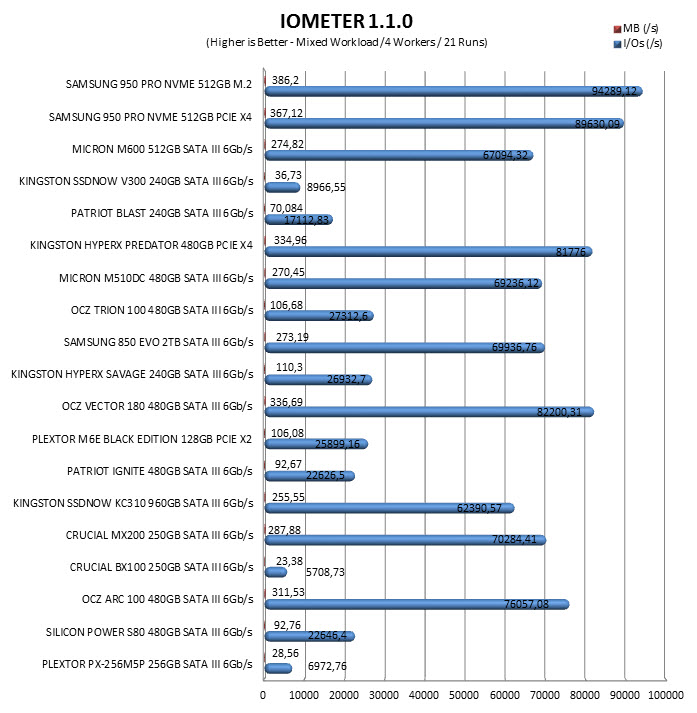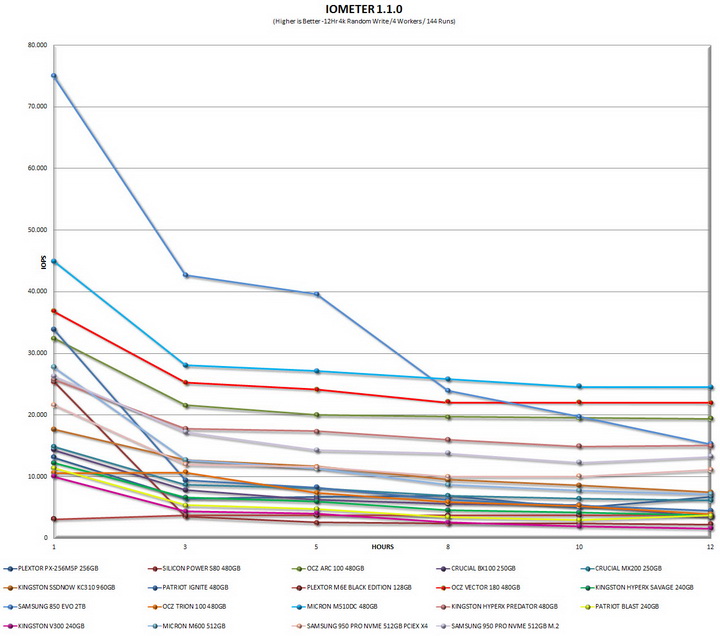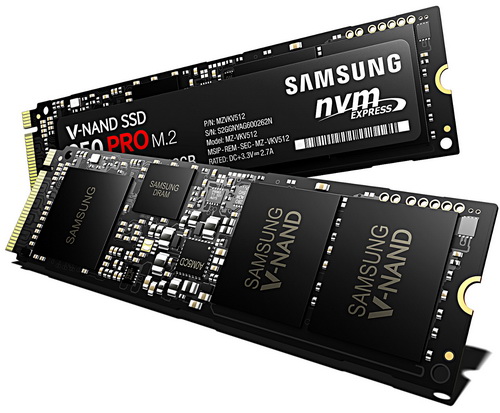INTRODUCTION
SATA 3 based solid state drive models are still among the hottest hardware components currently in the market but their performance is clearly being overshadowed by what the newer M.2 and PCIe models are capable of. Obviously the current performance limitations serial ATA (v3/3.1) has (600MB/s) have somewhat "forced" manufacturers to focus their resources towards the development and release of newer v3.2 models which can reach data transfer speeds of up to 1969MB/s something which i can't say that it came as a surprise to all of us (even the 12Gbps SAS interface gets maxed out at 1500MB/s not to mention it costs quite a bit). What did come as a surprise however was the development of SSD drives featuring the latest NVMe communications interface/protocol (Non-Volatile Memory) by a small consortium of companies (Intel, Samsung, SanDisk, Dell, and Seagate) which can reach speeds of up to 2500MB/s. Intel was the first to launch a NVMe consumer drive (750 model) last year but Samsung followed soon afterwards (Samsung on the other hand launched the first enterprise grade model followed soon afterwards by Intel) with the 950 Pro line and today we'll be testing the 512GB model.
Samsung Electronics Co., Ltd. is a global leader in technology, opening new possibilities for people everywhere. Through relentless innovation and discovery, we are transforming the worlds of televisions, smartphones, personal computers, printers, cameras, home appliances, LTE systems, medical devices, semiconductors and LED solutions. We employ 236,000 people across 79 countries with annual sales of US$187.8 billion. Samsung's Memory Business offers the industry's most advanced and extensive range of memory semiconductor products. As a leader in both the design and manufacture of memory semiconductor since 1993, the business provides key memory products including dynamic random access memory (DRAM), static random access memory (SRAM), NAND flash memory, Solid State Drives (SSD) and a range of green memory solutions for use in PC, server and mobile applications. Samsung is also leading the industry in advancements of next generation DRAM and NAND flash technologies while nurturing future memory technologies.
As mentioned earlier the 950 Pro line of SSDs by Samsung is based on the new NVMe communications interface/protocol and follows the typical M.2 2280 form factor (80mm long) which we see a lot with PCIe models. It also features Samsung's tri-core 8-channel ARM-based UBX controller (also used in the SM951 model), 3D V-NAND 32-layer 128Gbit MLC NAND flash (also used in the 850 Pro models), 512MB LPDDR3 DRAM and fully supports AES-256 hardware encryption, TCG Opal 2.0 (eDrive), TRIM, Garbage collection and DevSleep (power save mode). Samsung covers the 950 Pro line with a 5 year warranty and also states that the 512GB model has an MTBF of 1.5 million hours with an TBW (Total Bytes Written) of 400TB. Now as many of you know our primary test rig on which we've been testing SATA III and PCIe SSDs for almost 4 years now is based on the Intel X79 chipset and so it doesn't come with a M.2 connector. So because of that we decided to test the 950 Pro 512GB with a PCIe x4 card on our test rig and on its own by plugging it in a Z170 test rig. That way not only can we record performance differences between PCIe x4 and M.2 but all of you who may not own a M.2 compatible motherboard will see if it's worth pairing the 950 Pro with a PCIe adapter instead of upgrading your systems (took some time to complete tests on both systems but we think it was well worth it).
SPECIFICATIONS AND FEATURES

PACKAGING AND CONTENTS
The very small box has a large product picture at the front along with their logo and the model capacity.
You can find the product serial number on a small sticker at the base of the box right next to its country of origin.
The product serial numbers and barcodes are placed at the rear of the box right beneath several certification logos and the 5 year warranty.
Aside the cardboard box the 950 Pro is placed inside a clear plastic protective.
Inside the box you will find just the 950 Pro and the user manual.
THE 950 PRO 512GB
The 950 Pro follows the typical 80mm long design as every other M.2 (2280) drive out in the market.
As you can see the rear is empty so perhaps in the near future Samsung may place modules there to boost a 1TB model (it's possible).
Removing the top sticker reveals the two NAND flash modules, the 512MB LPDDR3 DRAM module and the UBX controller.
Each module is 256GB in size.
The UBX NAND flash controller is known to run a bit hot so we will check that out too in this review.
M.2 drives are fully compatible both with M.2 mainboard connectors and PCIe adapters (cards).
To test the 950 Pro 512GB with our X99 based test rig we used a PCIe-NVMe 3.0 x4 adapter by Lycom (keep in mind that regular M.2 adapters are not compatible with the NVMe models like the 950 Pro).
This adapter has room for M.2 cards up to 110mm in length so the 950 Pro left some room to spare.
The 950 Pro installed in the Z170 test rig.
TEST BED




TESTING METHODOLOGY
After roughly 8 years of testing sold state drives i have concluded that it's almost impossible for any single benchmark suite to accurately measure their performance and that's why in certain benchmark suites we see amazing read/write performance numbers with some drives while in others things are quite different. The reason behind this is that some benchmarking suites are configured to read and write random chunks of data while others read and write constant (sequential) ones. So that's why i always use a very wide selection of benchmarking suites including AIDA64, HD Tach RW, HD Tune Pro, Crystal Disk Mark, Sisoftware Sandra Pro, AS SSD, IOmeter and ATTO. To get the most accurate results each test gets repeated a total of 6 times with the average performance numbers recorded into our charts. Also as of February 25th 2015 our results will also include the Storage Networking Industry Association’s (SNIA) IOMeter tests. These tests include a 12 Hour write test used to “simulate” performance degradation over time and a mixed workload test which basically shows what you can expect when using an SSD continuously for roughly two hours. Unfortunately due to the time required for these tests we repeat them a total of 3 times and not 6 as the above.
Many people have made inquiries about our charts in the past so once again please do keep in mind that the Charts have the average performance numbers of each drive recorded and not the peak (highest) ones. Also although every single one of these programs can help potential buyers choose the right drive for their needs you should also remember that from any kind of benchmark up to real world usage the gap is not small (and usually most differences will go unnoticed by most people). All tests were performed in a fresh Windows 7 Ultimate x64 installation with every update installed up to February 12th 2016 (The Core i7-6700k system runs a fresh Windows 10 Pro x64 installation).
TEST RESULTS - AIDA64 / ATTO


TEST RESULTS - HD TACH RW / HD TUNE PRO


TEST RESULTS - SISOFTWARE SANDRA PRO / CRYSTAL DISK MARK X64


TEST RESULTS – AS SSD / IOMETER


TEST RESULTS – IOMETER SNIA
CONCLUSION
Noone here knows just how long NVMe will stay in the spotlight before it gets replaced by something even more durable and faster but until that happens this is as fast as SSDs can go. It goes without saying really that most consumers may never get to really “use” the performance levels offered by the 950 Pro (especially the 512GB model which we tested) but if the price is right and on par with many “regular” PCIe SSD models I don’t see why people should choose those instead. The only “slight” drawback is that your mainboard needs to have an M.2 connector (and you may also need to install Samsung’s NVMe driver) but It’s quite clear from our charts that even with a PCIe x4 adapter people without such mainboards can get pretty good results that surpass regular PCIe models. Unfortunately although our Core i7 3930k rig has a total of 12 Noctua fans and thus airflow is not a problem while testing the 950 Pro in the Z170 rig we did notice some performance irregularities (throttling) due to high temperature buildup. This shouldn’t be a problem with regular everyday use but just in case it does happen be sure to improve airflow levels inside your case (or place a small fan right over the drive).
Samsung has a way of nailing it when it comes to pricing and the 950 Pro line is no different since currently the 512GB model retails for USD327 inside the USA (Amazon.com) and for 313Euros inside the EU (Amazon.co.uk) so it doesn’t cost more than regular PCIe models. The price is by no means low since you can find 480/512GB SATA III SSDs for half as much but if you need the extra horsepower and durability or if you just want the best available the 950 Pro 512GB M.2 NVM Express SSD is the clear winner and that’s why it gets our Platinum Award.

PROS
- Excellent Build Quality
- Top Of The Charts Read & Write Performance
- 1.5 Million Hours MTBF
- M.2 / PCIe Solution
- 5 Years Warranty
- Price (For Some)
CONS
- Heat Buildup

 O-Sense
O-Sense


























.png)

